More than any American car, the Corvette leads people to assume that owners buy them to make a statement. Opinions on what that statement is, however, vary from “mid-life crisis” to “toy I always wanted” to “accessory that attracts the attractive.” I’ve never owned one, but in my opinion all of those statements miss the mark. This 1971 Chevrolet Corvette in Webster, New York could serve all of those purposes, but it could also illicit deeper pride of ownership that straight-up ignores what other people see or think. Offered as a numbers-matching coupe with original engine and four-speed transmission, this Chevy needs rust repair including parts of the bird cage, so if you don’t know what that means, keep your mouse away from the Place Bid button here on eBay. Lively bidding among at least 10 suitors has the market value elevated beyond $5500 with a few days left in the auction.
Described as a “300 HP” V8, the original stock 350 cid (5.7L) small block V8 would have made 270 HP (gross) and the hotter LT1 made 330, according to lov2xlr8. Metal shown here looks more solid than many old Corvettes we’ve seen. Stock exhaust manifolds bode well for other stock parts having been retained. That might be a GM HEI (High-Energy-Ignition) unit from the mid to late ’70s.
Back to the phrase “bird cage.” While the fiberglass body will never rust, and even frame repairs can be accomplished by many amateur welders, these Corvettes also feature a structural metal “bird cage” that comprises the superstructure surrounding the passengers including a box that defines the firewall, supports the metal windshield frame, and extends nearly to the rear wheels. Ignore this metal or entomb it in body filler and you haven’t done a restoration… you’ve done a serious injustice, and possible compromised the car’s safety. On a lighter note, the earlier chrome bumper C3 (third generation Corvette) specimens bring a premium over later body-colored bumper models.
The blue theme continues inside. As a young motorhead I enjoyed peering into the cockpit of Corvettes to read the nifty console plate enumerating the car’s original engine size and horsepower. A host of interior and other parts have merely been removed for a stalled restoration and do come with the car.
Credit the seller for including a host of undercarriage and other pictures that show some good and some bad. One bad area is this upper windshield frame. If I bought a Corvette, and I hope to some day, it would be to experience America’s Sports Car first hand. I wouldn’t have to thrash it, though I might wring it out once in a while. I have always been impressed with the ‘Vette’s pedigree and singular purpose. It’s not a version of any other car; the Corvette stands alone, with a rich history of racing and technological advances that helps General Motors improve far more plebeian cars that pay the bills. It also seems fitting that this halo shines on Chevrolet, General Motors’ entry-level brand, connecting that passion for performance with blue-collar Chevy-drivers everywhere. What do you love about Chevrolet’s historic Corvette?
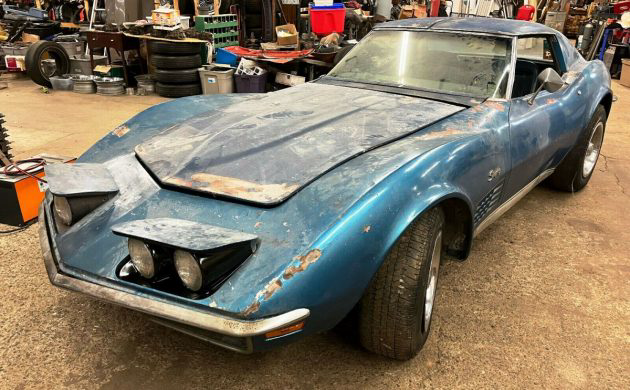
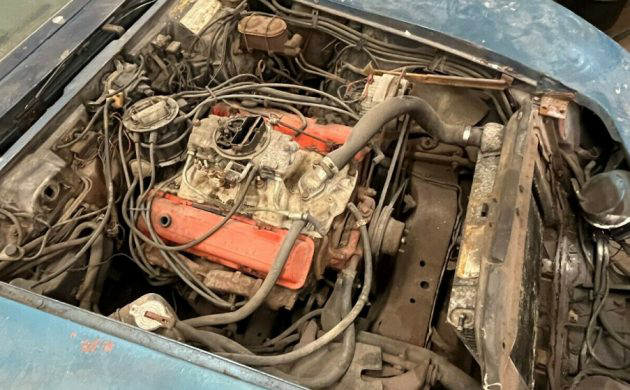
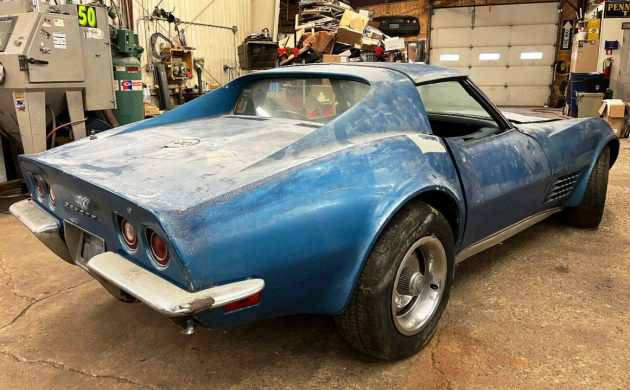
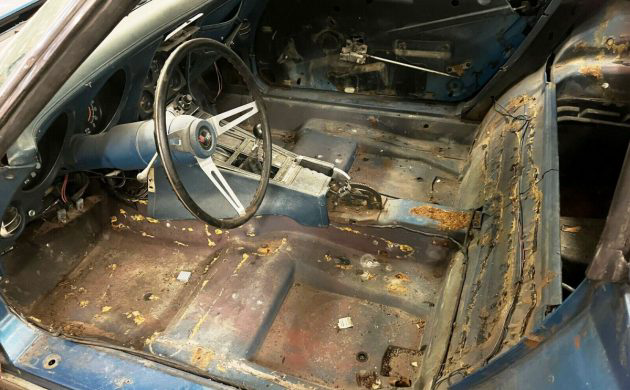
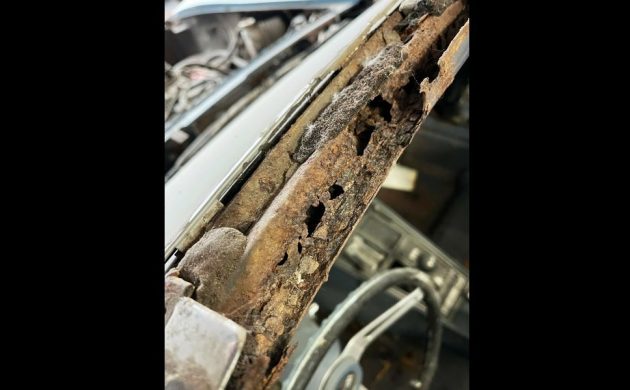

Nice one, Todd! I can see you turning this into a jewel box. I dare you to add it to your collection. (hee hee) (wringing hands)…
Unless you own a body and paint shop, you would be farther ahead buying a turn key example than this can of worms.
Windshield frame image does not bode well for the All-Wise and All-Knowing “Birdcage”.
You guys crack me up, not every corvette has a birdcage rusted to nothing. Most of the corvettes I bought needed body work but only a couple had birdcage issues. The people on here talk like every corvette for sale us likely a rust bucket underneath.
We want you to be happy.
You have to wonder how a car like this gets in this condition.
That’s easy, they weren’t built to last 50 years. No one expected people to be keeping these things around forever.
The windshield frame rust is quite common on 68-82 Corvettes, especially on cars parked outside, though this one is worse than most. There are two moldings, an outer windshield molding and a header molding. Where they meet there’s a slight gap, that GM put a strip of sealant under. With time, the sealant dries up, shrinks up and stops working, allowing water into the space where it starts to rust the windshield frame.
Many cars are subject to frame rust. On Corvettes it happens to be the area ahead of the rear wheels, where water, mud, etc gets caught in the end cap of the frame, causing that area to rot out.
I had a ’70 conv that I traded a ’75 formula for. It was a FL car in CT. Was garaged when I had it from ’81-’99 but now recall seeing some caulk of some sort in areas of that conv’s wide, stainless piece up top the windshield. I never yanked it to see under it though. Had 52k miles when got it. Now I wonder when the guy restored it, if that was an issue. Wasn’t aware as I was 20 then.
It got into this condition for being in the snow belt of upstate NY. One photo shows the end cap of the frame with holes. At least the seller is not hiding anything. For a legit LT-1, it MIGHT be worth the work, but a base car with few options NO.
I had forgotten how ugly these Corvettes are. Thanks for the reminder!
Contrary to what people in the sunbelt think, we don’t drive our Corvettes, Porsches, Ferraris, etc., etc., in the winter. I live in Toronto and can count on one hand the number of Corvettes that I have seen driving in the snow in the last 50 years!
Bravo! Primo. I tried driving my 1976 in the snow around my neighborhood (Neighbourhood) once to see what would happen. Whoo-Hooo! For the past 35 years the Sumatra Corvettes spend six months a year under cover.
GO LEAFS! GO TI-CATS! OSKEE-Wee-Wee!
When I first started playing with Corvettes in the 70’s, half the people I knew with Corvettes, used them as daily drivers. Back then they were just cars, great cars but still just cars.
Always having a company car or truck, I never used “my” Corvettes as daily drivers, but my wife’s Corvettes were always her main form of transportation. When we got engaged in 79, I bought her a 74 L-82 4 speed coupe. She drove the 74 every day, through rain, shine and snow here in NJ, until November 81 when we traded it in on a new 81. The 81 was her daily driver till November 84, when she was pregnant and needed a car a car seat would fit in. Only then did the 81 become a weekend toy, and it still is today.
About 20 years ago, I met the person who bought the 74 we traded in. He still had it and even though it was by then a play car, it had been his daily driver for most of the 80’s, including for 4 years when he was stationed in Colorado.
Yea George Just about everything here in the rust belt of new Yawk i Nit s rotten, with a few exceptions, especially ‘vettes, But at least you know this going in. Mark, I dont know where you are but if you see a ‘vette for sale here its rotten one place or another. Not being a ‘vette guy I’m not sure how you would fix this without using anotheer body section. Not a walk in the park. Good luck and happy bidding.
Cheers
GPC
I buy them wrecked and put them back together, paint and sell. I have done about 15 Vette’s and can think of 2 times that I needed to work on bird cage problems. My point was according to everyone that posts on here every corvette has or will have birdcage issues and that is not remotely accurate. Like anything you need to take a good look before you buy.
Yes, birdcage rust will be a major issue with these, and as long as you know about it, you can factor it in because it is repairable. I equate it to buying an old Mopar, Chevelle, Mustang, etc with major rust – it’s up to you and your talents / wallet that will dictate if the project will be worth it.
In my case, I did not know about it on my ’70 convertible. The top of the windshield frame was rotted and I found out when driving on rough roads and rust flakes ended up on my lap.
Fortunately, I found an expert that was able to take a good windshield frame and weld it in about halfway up the windshield. It didn’t cost much and the windshield fit perfectly and never leaked.
The rest of the birdcage was okay, but I can tell you how to quickly check:
Pull the chrome cover off the top of the windshield frame, pull at least one of the interior windshield vinyl trims off. Finally, remove at least one of the kick panels off. All you need to do this is a #2 Philips Head screwdriver.
Rust problems on Corvettes. Try rust problems on Panteras! Another no fun project.
The Stingray needs a lot of work. Having said this, it would be a crime for it to disappear as a bunch of parts used on other projects. After all, it is a very beautiful classic that deserves to survive. Hopefully someone who knows a lot about these, and who can do a lot of the work, without having to pay shops, will adopt it as a long-term project, finish it eventually, and save it for posterity.